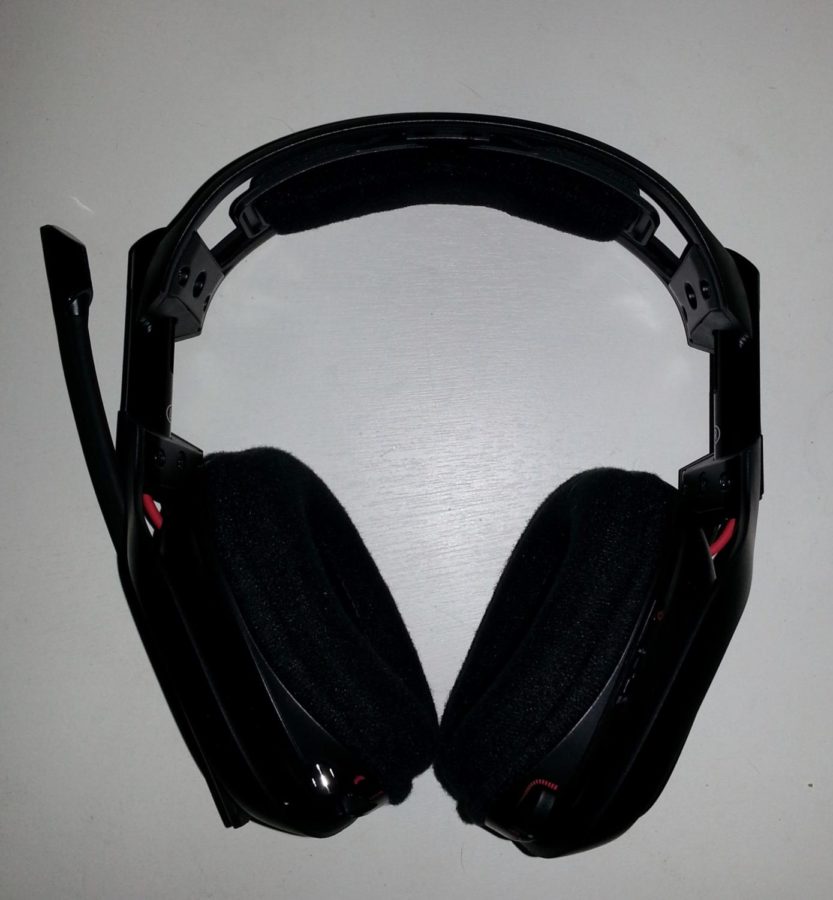Gamer’s Domain: Astro A50 gaming headset review
October 24, 2013
Headsets are a cool accessory for gaming, but not always warranted by their usually high prices. For years, I have been gaming with a cheap headset and my own surround sound speakers, but, by way of recent events, have come into possession of a very premium set of Astro A50s. Here is the quick story:
A few months ago, I posted this story to Reddit, describing how I play Battlefield with my uncle. EA and DICE privately contacted me, saying that they were moved by my story and they could see how much of a BF fan we were. I gave them my contact information after they told me they would send me some complementary dog tags. I thought, “Hey, cool!” but I never expected what they sent instead. Here is the package I got last week (which, of course, I had to tell Reddit about). And thus, here we are. On with the review.
**The generosity of DICE/EA’s gift does not effect my opinion on this product.**
I have had my eyes on the A50s long before they fell into my lap. People everywhere rave about how Astro is the premium choice for gaming headsets, with many people saying it puts Turtle Beach to shame. While I have owned a cheap $50 pair of Turtles for many years, I figured I would upgrade to something else when the new consoles launched. All I have to say after my time with the A50s is that the hype was worth it. Should these have never been sent to me, I would hope that I would have gone with them anyway.
Let us go down the feature list, as seen on the box and on the website: the A50s have wireless 5.8GHZ connectivity for zero interference, a built-in MixAmp, Dolby Digital 7.1 virtual surround sound, precision microphone, sturdy build, multi-system compatibility and superior sound.
So, which of these claims hold up? Which of them are as exciting as they sound? Get ready for this: all of them. Without a doubt, this headset produces the best sound I have ever heard. It has transformed the way I listen to things, as well as giving me a new appreciation for sound design.
The first thing I noticed about the A50s is that they are not very flashy… at all. If I did not know anything about headsets, I would look at it and think that given its rather boring appearance, it probably is not that great. But what the A50s show is that you do not need Afterglow-esque aesthetics to please the customer; it is all about the sound.
Before we get into the sound, however, I must say that the A50s are pretty heavy. Weight can give a premium feeling, one that this certainly accomplishes, but it can also be a nuisance. I have not yet gotten used to the significant feeling of the A50s sitting on my head, but I have had less than a week to adapt to them. Still, for people used to earphones or no sound gear at all, this could be a negative.
Aside from that, the feel is just sturdy. The A50s are height-adjustable, and the earpieces can fold flat for travel or storage. It would take some effort to break these, even if I was the type of gamer who raged by throwing his things. With the rigidity comes comfort where you need it most: the earcups. Over-ear is always the way to go with headsets, blocking out external noise and helping with the virtual surround sound experience. My Turtle Beaches always turned wearing my glasses and the headset into a comfort issue, but there’s no soreness to be found with the Astros. I get complete comfort while listening to the glorious sound they produce.
The A50s have Dolby Digital 7.1, or really, a virtual version of a seven-speaker-and-one-subwoofer setup. What this means is that sounds, if designed and supported to do so, can be situational and proximity-sensitive to the user. Should I be playing Battlefield and a helicopter is above me, the virtual 7.1 sound drivers in the A50s let me pinpoint exactly where the helicopter was, is and will be. Using the doppler effect and our instinctually good situational awareness together to find enemies is one of the coolest things to be done in gaming. It’s so advantageous that it feels like cheating most of the time. For instance, if I were in a completely pitch black room in a game, and an enemy was in there with me, I would be able to pinpoint exactly where he was the second he made a sound. That’s how accurate it is. The 7.1 system can be turned off, too, should it not sound right with some kinds of music, which is an issue I ran into.
The headset has a nice bass system too. There are three listening presets to choose from, one for each type of popular media (they are called media, core and pro). Pro is meant for gaming, as evidenced by the enhanced attention to sound detail that your typical pop song will not consist of. The core and media settings do just fine for everything else, with all three having a booming bass and, of course, that incredible communication between both earcups that makes you feel immersed in whatever you are listening to. Despite the impressive fidelity of the headset’s bass, nothing beats a real subwoofer, so be sure to leave your stereos on while using the A50s for maximum epic sound.
All of that impressive sound is beamed over a 5.8GHZ connection from the Astro MixAmp TX, a small wireless transmitter that acts as the central hub for the A50s. All sound connections fit to the TX, as well as a charging cable for when you hang the A50s up on the included stand to charge. The TX is a robust, yet subtle little thing, able to handle a suit of inputs that even sound cavemen will be able to appreciate. With AUX, optical out and optical in, almost every device with the capability of outputting sound can be routed to the TX, thus to your A50s.
For instance, I have a very old Xbox 360. As in, the original launch console. Do not ask me how it is still running. Anyway, it is so old that it does not have what many other models (both 360 and PS3) do: an optical out port.
To briefly explain: optical sound is to audio what HDMI is to video. It is high-definition, high quality, and overall just better sound. And, given my ancient 360, I can not experience optical sound without an expensive receiver that I cannot afford.
But that is okay, because through a quick workaround, I was able to hook up my 360 to the Astro TX receiver via an AUX jack, which is your standard 3.5mm headphone source. What this means is that I can listen to the sound my 360 outputs, but it is not exactly at the best quality. I would notice an extreme difference if I could be listening to audio through an optical cable’s connection, but luckily my gaming laptop supports such an output. So, when hooking up the headset to my computer, I noticed what I described above as the true 7.1 virtual SS experience. Remember, I am not saying that current consoles cannot do it, I am saying that mine cannot. My uncle, who got the exact same package as I did from EA/DICE, has a 360 that supports optical out and he says the SS on the headset is “mind-blowing.”
While the AUX option in the receiver really saved my bacon, that is because I was lucky enough to have some converters and adapters laying around to make it work. But what about folks who do not have a good stereo or are still using RCA (the red, white and yellow connectors) to have their sound and video?
Well, the sad truth is that without a complex workaround like what I had to do to my system, these people will not be able to use the Astro A50s. However, given the price of these things, their targeted market and what they are clearly meant for, I would hope that someone without HDMI, optical audio or any other modern entertainment media would be able to recognize that these are not meant for their older products. They are meant for newer, modern setups with optical inputs/outputs, HD TVs and booming surround sound systems.
Speaking of which, the TX receiver has an awesome feature that lots of other headset bundles do not: an optical passthrough. With both opt-in and opt-out ports, the TX allows HD audio to flow through it and still be passed along to your external speakers like nothing happened. This means you can enjoy your virtual surround sound with your A50s while your friends can still benefit from the conventional speaker setup.
The mic is amazing on the A50s as well. You would never guess that you were talking through a mic if you were to hear yourself on a recorded audio clip, and a returning feature that I love is the ability to hear yourself talk when using the mic. What happens is that everything the mic picks up, specifically your voice, is instantly relayed through to the earcups. It is not annoying, as it probably sounds. Instead, it is insightful and eerily relaxing. It lets you know if you are being too loud while also confirming that the mic is indeed working. As for the relaxing part, I can not really describe it. But once you have used the feature, you will never want to go back to an ordinary mic again. It was one of my favorite features of my Turtles, and I am glad Astro uses it too.
Battery life seems to be holding up to the multiple-hour claims; I have been using the A50s for many hours and still have not had to hang them up to charge, which is done by plugging in a micro-USB cord that comes from the TX receiver. This charging method (using the micro-USB) allows anything with a USB port to charge the headset; it does not need to be the TX receiver. I could charge from my laptop if I wanted to.
Thankfully, you can choose different volumes for the voice chat and the game sounds that come through the headset. It is a bit of a clunky system though; I wish they had gone the Turtle Beach way and had two rotating dials on the headset instead of an odd balance-clicker that it currently incorporates. Tap at the front of one of the ear-cups to raise game volume over voice, tap at the back of the ear-cup for the inverse effect. It works, but not as well as having two wheels that I can dial in to my specific preferences. That is the only thing I miss about my old headset over the A50s. There is also a universal volume wheel that controls everything coming to the headset.
Overall, I am very pleased with the Astro A50s. It is an awesome headset and one that I will use for many years to come—it is almost guaranteed that they will be compatible with the next generation consoles, and if they are not right away, Astro and SONY and Microsoft will find ways to make them so. I could stand for them to look a little better, as well as have some buttons that do not feel so cheap, but the sound quality is top-notch and makes every other method of listening seem inferior.
Would I buy these for $300? Honestly, no. I have an excellent sound system as it is and am not as crazy about headsets as some people. Right now, I would put that money towards a new console or a new PC, or some current generation games you may have missed. But if you are looking to spend big bucks on some amazing virtual surround sound headsets, the A50s have my seal of approval.
4/5
















